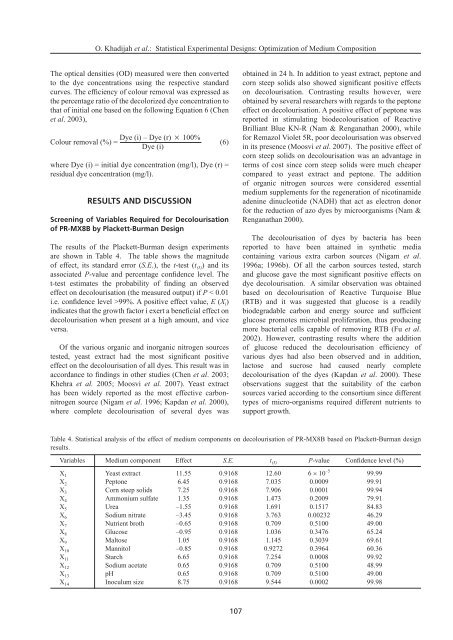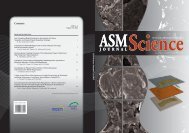ASM Science Journal, Volume 4(2), 2010(mg/l), X 3 = corn steep solids (mg/l), β 1 , β 2 , and β 3 = linearcoefficients, β 12 , β 13 , and β 23 = cross product coefficients.Analysis of the design experiments were carried outusing statistical software package Design Expert (Stat-EaseInc. Statistics Made Easy, Minneapolis, MN ver. 6, 1999).A total of 17 trials with five replicates at the centre pointwere employed to fit a second-order response surface. Allexperiments were done in triplicates and the mean responsevalues were used in the computation.Verification and Confirmation of the Proposed RSMModelFive out of the ten optimal conditions computed from theoptimization experiments were verified experimentally andcompared with the calculated data from the model. Similargeneral media was used with addition of yeast extract,starch and corn steep solids as indicated by the proposedmodel. A triplicate set of experiments were conducted andthe average of the three datasets was used to attain theoptimized point. The observed percentage decolourisationwas then compared to the predicted one as generated bythe software.MATERIALS AND METHODSMicro-organisms and Culture ConditionsThe selected bacterial consortium consist of three isolatesidentified as Chryseobacterium and Flavobacterium genusand was prepared by inoculating the individual strainsgrown overnight on nutrient agar plates in an Erlenmeyerflask containing 100 ml nutrient broth (NB). The culturemedia was shaken at 150 r.p.m. at room temperature andleft for 24 h.Media and ComponentsNutrient broth, yeast extract (YE), peptone, nutrientagar (NA), soluble starch, yeast extract peptone dextrose(YEPD) and yeast nitrogen base (YNB) were purchasedfrom Difco and corn steep solids was purchased fromSigma laboratory supplies. Media for the decolourisationexperiments contained (g/l): NaCl (2.0), MgSO 4 .7H 2 O(0.4), CaCl 2 .2H 2 O (0.5), MgCl 2 .6H 2 O (0.7), K 2 HPO 4 (0.3),and KH 2 PO 4 (0.3). The other variables were added andadjusted accordingly as listed in Table 1, 2 and 3.ChemicalsAll the general chemicals used were purchased from Sigma(USA), Merck (Germany) and BDH (England). Commercialtest kits for the determination of some of the environmentalparameters were purchased from HACH Company (USA).Depending upon the use, all chemicals were of Analar,HPLC or equivalent grade. PR-MX8B, a reactive azo dyewas obtained from the Textile Technology Laboratory,Faculty of Applied Sciences, Universiti Teknologi MARA,Shah Alam, Selangor.Decolourisation AssayDecolourisation of the individual dyes was determined attheir respective maximum absorption wavelength in theculture supernatants using a spectrophotometer. A sampleof culture broth was withdrawn daily and about 1 mlwas centrifuged at 10 000 r.p.m. for 15 min (EppendorfCentrifuge 5415), before its optical density was measured.Table 3. The actual Box-Behnken design for the three independent variables.Trial Yeast extract (g/l) Soluble Starch (g/l) Corn steep solids (g/l)1 –1 –1 02 1 –1 03 –1 1 04 1 1 05 –1 0 06 1 0 –17 0 0 –18 0 0 19 0 –1 110 0 1 –111 0 –1 –112 0 1 113 0 0 014 0 0 015 0 0 016 0 0 017 0 0 0106paper 1.indd 1061/20/2011 11:14:13 AM
O. Khadijah et al.: Statistical Experimental Designs: Optimization of Medium CompositionThe optical densities (OD) measured were then convertedto the dye concentrations using the respective standardcurves. The efficiency of colour removal was expressed asthe percentage ratio of the decolorized dye concentration tothat of initial one based on the following Equation 6 (Chenet al. 2003),Dye (i) – Dye (r) 100%Colour removal (%) =Dye (i)where Dye (i) = initial dye concentration (mg/l), Dye (r) =residual dye concentration (mg/l).RESULTS AND DISCUSSIONScreening of Variables Required for Decolourisationof PR-MX8B by Plackett-Burman DesignThe results of the Plackett-Burman design experimentsare shown in Table 4. The table shows the magnitudeof effect, its standard error (S.E.), the t-test (t (5) ) and itsassociated P-value and percentage confidence level. Thet-test estimates the probability of finding an observedeffect on decolourisation (the measured output) if P < 0.01i.e. confidence level >99%. A positive effect value, E (X i )indicates that the growth factor i exert a beneficial effect ondecolourisation when present at a high amount, and viceversa.Of the various organic and inorganic nitrogen sourcestested, yeast extract had the most significant positiveeffect on the decolourisation of all dyes. This result was inaccordance to findings in other studies (Chen et al. 2003;Khehra et al. 2005; Moosvi et al. 2007). Yeast extracthas been widely reported as the most effective carbonnitrogensource (Nigam et al. 1996; Kapdan et al. 2000),where complete decolourisation of several dyes was(6)obtained in 24 h. In addition to yeast extract, peptone andcorn steep solids also showed significant positive effectson decolourisation. Contrasting results however, wereobtained by several researchers with regards to the peptoneeffect on decolourisation. A positive effect of peptone wasreported in stimulating biodecolourisation of ReactiveBrilliant Blue KN-R (Nam & Renganathan 2000), whilefor Remazol Violet 5R, poor decolourisation was observedin its presence (Moosvi et al. 2007). The positive effect ofcorn steep solids on decolourisation was an advantage interms of cost since corn steep solids were much cheapercompared to yeast extract and peptone. The additionof organic nitrogen sources were considered essentialmedium supplements for the regeneration of nicotinamideadenine dinucleotide (NADH) that act as electron donorfor the reduction of azo dyes by microorganisms (Nam &Renganathan 2000).The decolourisation of dyes by bacteria has beenreported to have been attained in synthetic mediacontaining various extra carbon sources (Nigam et al.1996a; 1996b). Of all the carbon sources tested, starchand glucose gave the most significant positive effects ondye decolourisation. A similar observation was obtainedbased on decolourisation of Reactive Turquoise Blue(RTB) and it was suggested that glucose is a readilybiodegradable carbon and energy source and sufficientglucose promotes microbial proliferation, thus producingmore bacterial cells capable of removing RTB (Fu et al.2002). However, contrasting results where the additionof glucose reduced the decolourisation efficiency ofvarious dyes had also been observed and in addition,lactose and sucrose had caused nearly completedecolourisation of the dyes (Kapdan et al. 2000). Theseobservations suggest that the suitability of the carbonsources varied according to the consortium since differenttypes of micro-organisms required different nutrients tosupport growth.Table 4. Statistical analysis of the effect of medium components on decolourisation of PR-MX8B based on Plackett-Burman designresults.Variables Medium component Effect S.E. t (5) P-value Confidence level (%)X 1 Yeast extract 11.55 0.9168 12.60 6 × 10 –5 99.99X 2 Peptone 6.45 0.9168 7.035 0.0009 99.91X 3 Corn steep solids 7.25 0.9168 7.906 0.0001 99.94X 4 Ammonium sulfate 1.35 0.9168 1.473 0.2009 79.91X 5 Urea –1.55 0.9168 1.691 0.1517 84.83X 6 Sodium nitrate –3.45 0.9168 3.763 0.00232 46.29X 7 Nutrient broth –0.65 0.9168 0.709 0.5100 49.00X 8 Glucose –0.95 0.9168 1.036 0.3476 65.24X 9 Maltose 1.05 0.9168 1.145 0.3039 69.61X 10 Mannitol –0.85 0.9168 0.9272 0.3964 60.36X 11 Starch 6.65 0.9168 7.254 0.0008 99.92X 12 Sodium acetate 0.65 0.9168 0.709 0.5100 48.99X 13 pH 0.65 0.9168 0.709 0.5100 49.00X 14 Inoculum size 8.75 0.9168 9.544 0.0002 99.98107paper 1.indd 1071/20/2011 11:14:13 AM
- Page 1 and 2: In Pursuit of Excellence in Science
- Page 3 and 4: INTERNATIONAL ADVISORY BOARDAhmed Z
- Page 5 and 6: OSThe Academy of SciencesMalaysia (
- Page 7: Contentsasm Sc. J.Volume 4(2), 2010
- Page 10 and 11: ASM Science Journal, Volume 4(2), 2
- Page 16 and 17: Decolourisation (%)79.4968.1156.744
- Page 18 and 19: ASM Science Journal, Volume 4(2), 2
- Page 20 and 21: ASM Science Journal, Volume 4(2), 2
- Page 22 and 23: ASM Science Journal, Volume 4(2), 2
- Page 24 and 25: Temperature (ºC)MO46 MO55 MO64 MO7
- Page 26 and 27: ASM Science Journal, Volume 4(2), 2
- Page 28 and 29: ASM Science Journal, Volume 4(2), 2
- Page 30 and 31: ASM Science Journal, Volume 4(2), 2
- Page 32 and 33: Expression based on raw arbitrary i
- Page 34 and 35: (A)(B)(C)Figure 4. Expression of RI
- Page 36 and 37: ASM Science Journal, Volume 4(2), 2
- Page 38 and 39: ASM Science Journal, Volume 4(2), 2
- Page 40 and 41: paper 4.indd 134L 1LmH k ( z) L hk
- Page 42 and 43: ASM Science Journal, Volume 4(2), 2
- Page 44 and 45: Samples 10 4-531 Proposed2 Critical
- Page 46 and 47: 3 Conventional-400 0.5 1.0 1.5 2.0I
- Page 48 and 49: ASM Sci. J., 4(2), 142-148Prelimina
- Page 50 and 51: ASM Science Journal, Volume 4(2), 2
- Page 52 and 53: 2.02.01.0Current Current (Amp (Amp
- Page 54 and 55: ASM Science Journal, Volume 4(2), 2
- Page 56 and 57: ASM Science Journal, Volume 4(2), 2
- Page 58 and 59: ASM Science Journal, Volume 4(2), 2
- Page 60 and 61: -1/2 -1/2Nux Nux x Re x Re xx24.024
- Page 62 and 63:
ASM Science Journal, Volume 4(2), 2
- Page 64 and 65:
ASM Sci. J., 4(2), 158-172Intrinsic
- Page 66 and 67:
ASM Science Journal, Volume 4(2), 2
- Page 68 and 69:
ASM Science Journal, Volume 4(2), 2
- Page 70 and 71:
ASM Science Journal, Volume 4(2), 2
- Page 72 and 73:
ASM Science Journal, Volume 4(2), 2
- Page 74 and 75:
ASM Science Journal, Volume 4(2), 2
- Page 76 and 77:
ASM Science Journal, Volume 4(2), 2
- Page 78 and 79:
ASM Science Journal, Volume 4(2), 2
- Page 80 and 81:
ASM Science Journal, Volume 4(2), 2
- Page 82 and 83:
ASM Science Journal, Volume 4(2), 2
- Page 84 and 85:
ASM Science Journal, Volume 4(2), 2
- Page 86 and 87:
ASM Science Journal, Volume 4(2), 2
- Page 88 and 89:
ASM Science Journal, Volume 4(2), 2
- Page 90 and 91:
ASM Science Journal, Volume 4(2), 2
- Page 92 and 93:
ASM Science Journal, Volume 4(2), 2
- Page 94 and 95:
ASM Science Journal, Volume 4(2), 2
- Page 96 and 97:
CMYCMMYCYCMYK
- Page 98 and 99:
22nd Pacific Science CongressASM Sc
- Page 100 and 101:
CMYCMMYCYCMYK
- Page 102 and 103:
ASM Science Journal, Volume 4(2), 2
- Page 104 and 105:
ASM Science Journal, Volume 4(2), 2
- Page 106 and 107:
ASM Science Journal, Volume 4(2), 2
- Page 108 and 109:
ASM Science Journal, Volume 4(2), 2
- Page 110 and 111:
cover 4(2).indd 1RESEARC H ARTICLES
- Page 112 and 113:
Whole citation• The different det
- Page 114 and 115:
Academy of Sciences Malaysia902-4,

















